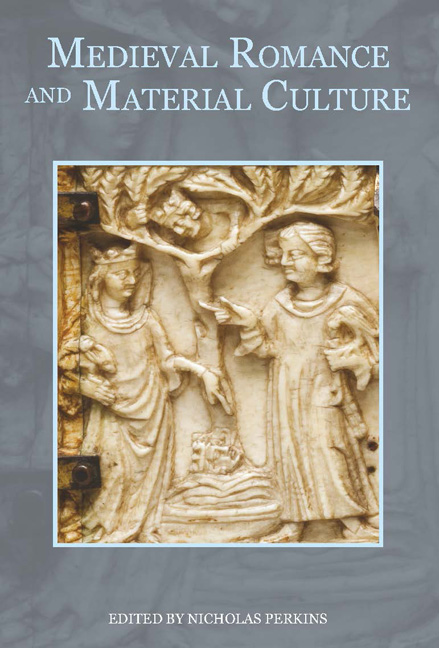Book contents
- Frontmatter
- Contents
- List of Illustrations
- List of Contributors
- Acknowledgements
- Abbreviations
- 1 Introduction: The Materiality of Medieval Romance and The Erle of Tolous
- 2 Courtly Culture and Emotional Intelligence in the Romance of Horn
- 3 Emplaced Reading, or Towards a Spatial Hermeneutic for Medieval Romance
- 4 Devotional Objects, Saracen Spaces and Miracles in Two Matter of France Romances
- 5 The Werewolf of Wicklow: Shapeshifting and Colonial Identity in the Lai de Melion
- 6 ‘Ladyes war at thare avowing’: The Female Gaze in Late-Medieval Scottish Romance
- 7 The Evolution of Cooperation in The Avowyng of Arthur
- 8 Ritual, Revenge and the Politics of Chess in Medieval Romance
- 9 Adventures in the Bob-and-Wheel Tradition: Narratives and Manuscripts
- 10 Reading King Robert of Sicily's Text(s) and Manuscript Context(s)
- 11 The Circulation of Romances from England in Late-Medieval Ireland
- 12 The Image of the Knightly Harper: Symbolism and Resonance
- 13 Carving the Folie Tristan: Ivory Caskets as Material Evidence of Textual History
- 14 Romancing the Orient: The Roman d'Alexandre and Marco Polo's Livre du grand Khan in Oxford, Bodleian Library MS Bodl. 264
- 15 The Victorian Afterlife of The Thornton Romances
- Index
8 - Ritual, Revenge and the Politics of Chess in Medieval Romance
Published online by Cambridge University Press: 05 May 2015
- Frontmatter
- Contents
- List of Illustrations
- List of Contributors
- Acknowledgements
- Abbreviations
- 1 Introduction: The Materiality of Medieval Romance and The Erle of Tolous
- 2 Courtly Culture and Emotional Intelligence in the Romance of Horn
- 3 Emplaced Reading, or Towards a Spatial Hermeneutic for Medieval Romance
- 4 Devotional Objects, Saracen Spaces and Miracles in Two Matter of France Romances
- 5 The Werewolf of Wicklow: Shapeshifting and Colonial Identity in the Lai de Melion
- 6 ‘Ladyes war at thare avowing’: The Female Gaze in Late-Medieval Scottish Romance
- 7 The Evolution of Cooperation in The Avowyng of Arthur
- 8 Ritual, Revenge and the Politics of Chess in Medieval Romance
- 9 Adventures in the Bob-and-Wheel Tradition: Narratives and Manuscripts
- 10 Reading King Robert of Sicily's Text(s) and Manuscript Context(s)
- 11 The Circulation of Romances from England in Late-Medieval Ireland
- 12 The Image of the Knightly Harper: Symbolism and Resonance
- 13 Carving the Folie Tristan: Ivory Caskets as Material Evidence of Textual History
- 14 Romancing the Orient: The Roman d'Alexandre and Marco Polo's Livre du grand Khan in Oxford, Bodleian Library MS Bodl. 264
- 15 The Victorian Afterlife of The Thornton Romances
- Index
Summary
In the Stanzaic Guy of Warwick, a prince and a sultan's son begin a game of chess in which the contest rapidly expands beyond the bounds of the chequered board: one strikes the other in the face with a chess piece, before being bludgeoned to death by the chessboard in turn. In William Caxton's The Foure Sonnes of Aymon, the game of chess similarly offers the material for revenge and sociopolitical rupture. Here, the French vassal Renaud is provoked by Charlemagne's nephew Berthelot during a chess match, and slays him with the chessboard—in this case, instigating a blood feud between Charlemagne and Renaud's family that lasts for years and sprawls across nearly six hundred pages in the EETS edition. In contrast to representations of chess elsewhere in romances and other medieval literature, this motif of homicide in high-stakes chess subverts a material and textual touchstone familiar to medieval readers. Medieval chess conventionally operates as a metaphor for social order, as expounded most fully in tracts in the Jacobus de Cessolis tradition, including William Caxton's The Game and Playe of the Chesse. Especially when read in connection with this literature of counsel and conduct surrounding chess, and alongside the startling woodcut at the beginning of Caxton's second (1483) edition of The Game and Playe of Chesse, the murderous chess episodes in romances such as the Stanzaic Guy and Caxton's Foure Sonnes offer a troubling political symbolism. This article will argue that romance deployments of the materials of chess to do violence or murder constitute a very material rupture of ritual, on multiple levels.
The normative symbolism of chess as an affirmation of political hierarchy and societal integration is demonstrated in the early fourteenth-century romance Richard Coer de Lyon. Between battles in the early, successful portion of his crusading campaign, Richard occupies himself with a game of chess:
Kynge Rycharde playe
At the chesse in his galaye;
The Erle of Rychemonde with hym played,
And Rychard wan al that he layed.
- Type
- Chapter
- Information
- Medieval Romance and Material Culture , pp. 129 - 146Publisher: Boydell & BrewerPrint publication year: 2015



